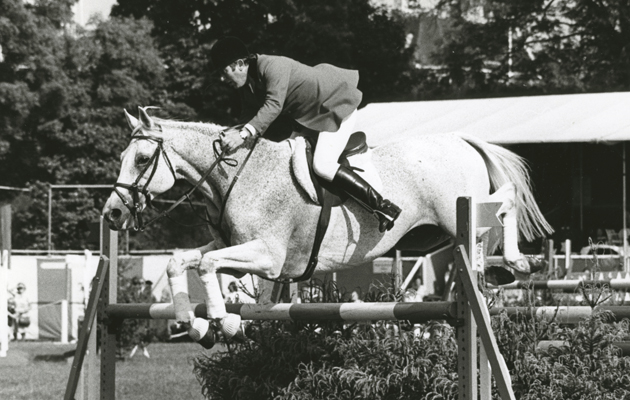This year’s Grand National isn’t the first to be called off – bomb scares and wars have played their part, too. Hannah Lemieux looks back on others that didn’t go to plan
On the first Saturday of April this year, the Grand National ’s traditional date, the gates of Aintree Racecourse remained closed. No horses graced the famous turf, primed for the biggest race of their lives, no jockeys dazzled in brightly coloured silks and no excited racegoers bustled into the historic Liverpool venue.
It was the first time in 75 years that the Aintree grandstands have fallen silent on the day of the world’s greatest steeplechase. Not since the end of World War II has the Grand National not taken place, but this time it was due to a pandemic that has halted the globe.
{"content":"PHA+VGhlIHJhY2UgYmVnYW4gaW4gMTgzOSBhbmQgZXZlbiBjb250aW51ZWQgdGhyb3VnaCBXb3JsZCBXYXIgSS4gRHVyaW5nIHRoZXNlIHllYXJzLCB0aHJlZSBOYXRpb25hbHMgdG9vayBwbGFjZSBhdCBHYXR3aWNrIFJhY2Vjb3Vyc2UsIGFuIG9sZCBjb3Vyc2UgdGhhdCBoYXMgc2luY2UgYmVjb21lIHBhcnQgb2YgR2F0d2ljayBBaXJwb3J0LiBUaGUgTmF0aW9uYWwgd2FzIHRoZW4gb2ZmaWNpYWxseSBzdXNwZW5kZWQgZnJvbSAxOTQxIHVudGlsIDE5NDUgZHVyaW5nIFdvcmxkIFdhciBJSS48L3A+CjxoMz5Mb3JkIEd5bGxlbmU6IDE5OTcgR3JhbmQgTmF0aW9uYWw8L2gzPgo8cD5JbiB0aGUgR3JhbmQgTmF0aW9uYWzigJlzIGxvbmcgaGlzdG9yeSB0aGVyZSBoYXZlIG9ubHkgYmVlbiBhIGhhbmRmdWwgb2YgdGltZXMgdGhlIHNwZWN0YWNsZSBoYXMgbm90IHF1aXRlIGdvbmUgdG8gcGxhbi4gQXNpZGUgZnJvbSB0aGUgbG9zcyBvZiB0aGUgMjAyMCByZW5ld2FsLCB0aGUgbW9zdCBmcmVzaCBpbiBwZW9wbGXigJlzIG1pbmQgaXMgdGhlIDE5OTcgR3JhbmQgTmF0aW9uYWwsIHdoZW4gYSBzdXNwZWN0ZWQgSVJBIGJvbWIgdGhyZWF0IG1lYW50IHRoYXQgdGhlIE5hdGlvbmFsIHdhcyBwb3N0cG9uZWQgYnkgdHdvIGRheXMuPC9wPgo8cD5Ud28gd2FybmluZ3Mgd2l0aCByZWNvZ25pc2VkIElSQSBjb2RlIHdvcmRzIHdlcmUgcmVjZWl2ZWQganVzdCBiZWZvcmUgdGhlIGpvY2tleXMgbW91bnRlZC4gVGhlIHRocmVhdCBsZWQgdG8gdGhlIGxhcmdlc3QgZXZlciBldmFjdWF0aW9uIG9mIGEgc3BvcnRpbmcgZXZlbnQgYXMgNjAsMDAwIHBlb3BsZSB3ZXJlIHJlbW92ZWQgZnJvbSBBaW50cmVlLCB3aGlsZSAxMDAgaG9yc2VzIGhhZCB0byBiZSBsZWZ0IHVuYXR0ZW5kZWQgZm9yIGZvdXIgaG91cnMuPC9wPgo8cD48ZGl2IGNsYXNzPSJhZC1jb250YWluZXIgYWQtY29udGFpbmVyLS1tb2JpbGUiPjxkaXYgaWQ9InBvc3QtaW5saW5lLTIiIGNsYXNzPSJpcGMtYWR2ZXJ0Ij48L2Rpdj48L2Rpdj48c2VjdGlvbiBpZD0iZW1iZWRfY29kZS0zMSIgY2xhc3M9ImhpZGRlbi1tZCBoaWRkZW4tbGcgcy1jb250YWluZXIgc3RpY2t5LWFuY2hvciBoaWRlLXdpZGdldC10aXRsZSB3aWRnZXRfZW1iZWRfY29kZSBwcmVtaXVtX2lubGluZV8yIj48c2VjdGlvbiBjbGFzcz0icy1jb250YWluZXIgbGlzdGluZy0tc2luZ2xlIGxpc3RpbmctLXNpbmdsZS1zaGFyZXRocm91Z2ggaW1hZ2UtYXNwZWN0LWxhbmRzY2FwZSBkZWZhdWx0IHNoYXJldGhyb3VnaC1hZCBzaGFyZXRocm91Z2gtYWQtaGlkZGVuIj4NCiAgPGRpdiBjbGFzcz0icy1jb250YWluZXJfX2lubmVyIj4NCiAgICA8dWw+DQogICAgICA8bGkgaWQ9Im5hdGl2ZS1jb250ZW50LW1vYmlsZSIgY2xhc3M9Imxpc3RpbmctaXRlbSI+DQogICAgICA8L2xpPg0KICAgIDwvdWw+DQogIDwvZGl2Pg0KPC9zZWN0aW9uPjwvc2VjdGlvbj48L3A+CjxwPkpvdXJuYWxpc3QsIFRWIHByZXNlbnRlciBhbmQgZm9ybWVyIGpvY2tleSBCcm91Z2ggU2NvdHQgd2FzIHdyaXRpbmcgZm9yIHRoZSA8ZW0+U3VuZGF5IFRlbGVncmFwaDwvZW0+LCBzaGFkb3dpbmcgbGVnZW5kYXJ5IGNvbW1lbnRhdG9yIFBldGVyIE\/igJlTdWxsZXZhbiBmb3IgdGhlIGRheSwgd2hlbiB0aGUgY29tbW90aW9uIGtpY2tlZCBvZmYuIER1ZSB0byB0aGUgdGhyZWF0LCBhbGwgbW9iaWxlIHBob25lIHNpZ25hbHMgaGFkIGJlZW4gY3V0LCBzbyBCcm91Z2ggYW5kIGhpcyBUZWxlZ3JhcGggY29sbGVhZ3VlIE1hcmN1cyBBcm15dGFnZSB3ZXJlIGZyYW50aWNhbGx5IGxvb2tpbmcgZm9yIGEgaG9tZSBwaG9uZSBzbyB0aGV5IGNvdWxkIGZpbGUgdGhlaXIgY29weS48L3A+CjxwPuKAnFdlIHJhbiBkb3duIE1lbGxpbmcgUm9hZCwgbG9va2luZyBpbnRvIGVhY2ggaG91c2UgdG8gc2VlIGlmIHBlb3BsZSB3ZXJlIGluc2lkZSB0aGF0IHdlIGNvdWxkIGFzayB0byBib3Jyb3cgdGhlaXIgcGhvbmUs4oCdIHJlZmxlY3RzIEJyb3VnaC4g4oCcV2UgZm91bmQgYSBjb3VwbGUsIEpvaG4gYW5kIEFubmUgTm9ydGgsIHdobyB3ZWxjb21lZCB1cyBpbiBhbmQgd2Ugd2VyZSBkaWN0YXRpbmcgb3VyIGNvcHkgb3ZlciB0aGUgcGhvbmUu4oCdPC9wPgo8cD5NYXJjdXMgYWxzbyByZW1lbWJlcnMgdGhhdCBkYXkgdml2aWRseS48L3A+CjxkaXYgY2xhc3M9ImFkLWNvbnRhaW5lciBhZC1jb250YWluZXItLW1vYmlsZSI+PGRpdiBpZD0icG9zdC1pbmxpbmUtMyIgY2xhc3M9ImlwYy1hZHZlcnQiPjwvZGl2PjwvZGl2Pgo8cD7igJxUaGUgZm9yZWlnbiBzZWNyZXRhcnkgYXQgdGhlIHRpbWUsIFJvYmluIENvb2ssIGFsc28gam9pbmVkIHVzIGF0IHRoZSBob3VzZSBvbiBNZWxsaW5nIFJvYWQs4oCdIGFkZHMgTWFyY3VzLiDigJxJIGhhdmUga2VwdCBpbiB0b3VjaCB3aXRoIHRoZSBOb3J0aHMgZXZlciBzaW5jZSwgYW5kIHRoZXkgc3RpbGwgYWxsb3cgbWUgdG8gcGFyayBteSBjYXIgb24gdGhlaXIgZHJpdmV3YXkgZWFjaCBHcmFuZCBOYXRpb25hbCBkYXku4oCdPC9wPgo8cD5Qb2xpY2UgY2FycmllZCBvdXQgdHdvIGNvbnRyb2xsZWQgZXhwbG9zaW9ucyBhdCBBaW50cmVlIHRoYXQgZGF5LCBhbmQgdGhlIE5hdGlvbmFsIHdhcyByZS1ydW4gb24gTW9uZGF5LCA3IEFwcmlsLiBKb2NrZXkgVG9ueSBEb2JiaW4gd29uIG9uIExvcmQgR3lsbGVuZSBieSBhbiBlbXBoYXRpYyAyNSBsZW5ndGhzLjwvcD4KPGRpdiBjbGFzcz0iYWQtY29udGFpbmVyIGFkLWNvbnRhaW5lci0tbW9iaWxlIj48ZGl2IGlkPSJwb3N0LWlubGluZS00IiBjbGFzcz0iaXBjLWFkdmVydCI+PC9kaXY+PC9kaXY+CjxwPuKAnFRoZSBTYXR1cmRheSBzdGFydGVkIGxpa2UgYW55IG90aGVyIEdyYW5kIE5hdGlvbmFsIGRheSwgdGhlIGF0bW9zcGhlcmUgd2FzIHNlY29uZCB0byBub25lIGFuZCBJIGZlbHQgbHVja3kgdG8gYmUgYSBwYXJ0IG9mIGl0LOKAnSByZW1lbWJlcnMgVG9ueS4g4oCcV2UgaGFkIGFscmVhZHkgaGFkIG91ciBqb2NrZXkgYnJpZWZpbmcgaW4gdGhlIHdlaWdoaW5nIHJvb20sIHRoZSBob3JzZXMgaGFkIGJlZW4gc2FkZGxlZCwgb3VyIGNvbG91cnMgd2VyZSBvbiBhbmQgb3VyIGhhdCBzaWxrcyB3ZXJlIGJlaW5nIHRpZWQgd2hlbiBhbiBhbGFybSB3ZW50IG9mZi4gV2UgdGhvdWdodCBpdCB3YXMganVzdCBhIGRydW5rZW4gcmFjZWdvZXIgc2V0dGluZyB0aGUgZmlyZSBhbGFybSBvZmYsIHRoZW4gd2Ugd2VyZSB0b2xkIHRvIGxlYXZlIHRoZSB3ZWlnaGluZyByb29tLjwvcD4KPHA+4oCcQWZ0ZXIgcmVhbGlzaW5nIGl0IHdhcyBzb21ldGhpbmcgbW9yZSBzZXJpb3VzLCB3ZSBhbGwgZ290IHRha2VuIG91dCBvZiB0aGUgcmFjZWNvdXJzZSwgc3RpbGwgaW4gb3VyIGJyZWVjaGVzIGFuZCBib290cy4gQXQgdGhhdCBwb2ludCB3ZSBiZWxpZXZlZCB0aGUgTmF0aW9uYWwgaGFkIGJlZW4gY2FuY2VsbGVkLiBJdCB3YXMgZGV2YXN0YXRpbmcuIEkgd2FzIHBsYXlpbmcgZ29sZiBvbiB0aGUgU3VuZGF5IHdoZW4gbXkgYWdlbnQgcmFuZyBhbmQgdG9sZCBtZSB0aGUgTmF0aW9uYWwgd2FzIHJ1bm5pbmcgdGhlIG5leHQgZGF5IOKAkyBJIHdhcyBzaG9ja2VkIGJ1dCBvYnZpb3VzbHkgdmVyeSBleGNpdGVkLOKAnSBzYWlkIFRvbnkuPC9wPgo8ZGl2IGNsYXNzPSJhZC1jb250YWluZXIgYWQtY29udGFpbmVyLS1tb2JpbGUiPjxkaXYgaWQ9InBvc3QtaW5saW5lLTUiIGNsYXNzPSJpcGMtYWR2ZXJ0Ij48L2Rpdj48L2Rpdj4KPHA+V2l0aCBmcmVlIGVudHJ5IHRvIHJhY2Vnb2VycyBvbiB0aGUgTW9uZGF5LCBwZW9wbGUgZmxvY2tlZCB0aHJvdWdoIHRoZSBnYXRlcy48L3A+CjxwPuKAnFVzdWFsbHksIHlvdSBoYXZlIGEgY291cGxlIG9mIHJhY2VzIHRvIHdhcm0gdXAgZm9yIHRoZSBiaWcgb25lLCBidXQgbm90IHRoaXMgdGltZS4gSSBtYWRlIGFsbCB0aGUgcnVubmluZyBvbiBMb3JkIEd5bGxlbmUuIEl0IHdhcyBoaXMgZmlyc3QgR3JhbmQgTmF0aW9uYWwsIGhlIHdhc27igJl0IGFuIGFtYXppbmcganVtcGVyIGJ1dCBoZSBqdXN0IHRvb2sgdG8gdGhlIEFpbnRyZWUgZmVuY2VzLiBXZSBoYWQgb25lIHNjYXJ5IG1vbWVudCBhdCB0aGUgd2F0ZXIganVtcCwgd2hlbiB3ZSB3ZXJlIG5lYXJseSB0YWtlbiBvdXQgYnkgYSBsb29zZSBob3JzZSwgYnV0IExvcmQgR3lsbGVuZSB3YW50ZWQgdG8gc3RheSBpbiB0aGUgcmFjZSDigJMgeW91IGNvdWxkIGp1c3QgdGVsbC4gSSB3YXMga25hY2tlcmVkIGF0IHRoZSBmaW5pc2ggYnV0IHRoZW4gaXQgc3VkZGVubHkgaGl0IG1lIHRoYXQgSSBoYWQgd29uLCBJIGNvdWxkbuKAmXQgYmVsaWV2ZSBpdC7igJ08L3A+CjxoMz5UaGUgdm9pZCByYWNlOiAxOTkzIEdyYW5kIE5hdGlvbmFsPC9oMz4KPHA+VGhlIGRyYW1hcyBvZiAxOTk3IGNhbWUganVzdCBmb3VyIHllYXJzIGFmdGVyIGFub3RoZXIgdW51c3VhbCBpbmNpZGVudCBpbiB0aGUgaGlzdG9yeSBvZiB0aGUgR3JhbmQgTmF0aW9uYWwg4oCTIHRoZSBvbmx5IHRpbWUgdGhlIGJpZyByYWNlIGhhcyB5ZXQgYmVlbiBkZWNsYXJlZCB2b2lkLjwvcD4KPHA+QW50aS1yYWNlIHByb3Rlc3RvcnMgaGFkIGNhdXNlZCBoYXZvYyBhdCB0aGUgZmlyc3QgZmVuY2UgYmVmb3JlaGFuZC4gV2hlbiB0aGUgMzktcnVubmVyIGZpZWxkIGRpZCBsaW5lIHVwLCB0aGVyZSB3YXMgYW4gaW5pdGlhbCBmYWxzZSBzdGFydCwgdGhlbiBhIHNlY29uZC4gVW5mb3J0dW5hdGVseSBvbiB0aGlzIGF0dGVtcHQsIGp1c3QgbmluZSBvZiB0aGUgMzkgam9ja2V5cyB1bmRlcnN0b29kIGl0IHRvIGJlIGEgc2Vjb25kIGZhbHNlIHN0YXJ0IGFuZCB0aGUgb3RoZXJzIHNldCBvZmYgd2l0aG91dCByZWFsaXNpbmcuPC9wPgo8cD5FbGV2ZW4gY29tYmluYXRpb25zIGNvbXBsZXRlZCB0aGUgZmlyc3QgY2lyY3VpdCwgYmVmb3JlIHRoZSBqb2NrZXlzIGJlY2FtZSBhd2FyZSBvZiB0aGUgbWlzdGFrZSBhbmQgcHVsbGVkIHVwIHRoZWlyIG1vdW50cy4gQSB0b3RhbCBvZiBzZXZlbiByaWRlcnMgY29udGludWVkLCBkZXNwaXRlIHNob3V0cyBmcm9tIHRoZSBjcm93ZCBhbmQgb2ZmaWNpYWxzIHdhdmluZyBmbGFncywgY29tcGxldGluZyB0aGUgZm91ci1taWxlIGNvbnRlc3QuIEVzaGEgTmVzcywgcmlkZGVuIGJ5IEpvaG4gV2hpdGUgYW5kIHRyYWluZWQgYnkgSmVubnkgUGl0bWFuLCB3YXMgdGhlIGZpcnN0IGhvcnNlIHRvIOKAnHdpbuKAnSB0aGUgR3JhbmQgTmF0aW9uYWwgdGhhdCBuZXZlciB3YXMuPC9wPgo8cD5Gb3JtZXIgam9ja2V5IENhcmwgTGxld2VsbHluLCBub3cgYXNzaXN0YW50IHRvIHRyYWluZXIgTmlnZWwgVHdpc3Rvbi1EYXZpZXMsIHJlbWVtYmVycyB0aGUgdm9pZCBHcmFuZCBOYXRpb25hbCB3aXRoIGEgaGVhdnkgaGVhcnQuIEhlIHdhcyByaWRpbmcgdGhlIHByZXZpb3VzIHllYXLigJlzIHZpY3RvciwgdGhlIE5pY2sgR2FzZWxlZS10cmFpbmVkIFBhcnR5IFBvbGl0aWNzLCBhbmQgYmVsaWV2ZWQgaGUgd2FzIG9uIHRoZSB3aW5uZXIgb25jZSBhZ2Fpbi48L3A+CjxwPuKAnFdlIGhhZCBubyBpZGVhIGl0IHdhcyBhbm90aGVyIGZhbHNlIHN0YXJ0IHdoZW4gd2UganVtcGVkIG9mZiwgZXNwZWNpYWxseSB0aG9zZSBvZiB1cyBzYXQgb24gdGhlIG91dHNpZGUs4oCdIHJlZmxlY3RzIENhcmwuIOKAnEkgZGlkIGEgY2lyY3VpdCBhbmQgd2FzIHNpdHRpbmcgaW4gYWJvdXQgc2l4dGgsIGJlZm9yZSBwdWxsaW5nIHVwIGFmdGVyIHRoZSB3YXRlciBqdW1wIHdoZW4gSSBzYXcgc29tZW9uZSBmcm9tIE5pY2vigJlzIHlhcmQgc2hvdXRpbmcgYXQgbWUgdG8gc3RvcC48L3A+CjxwPuKAnEhhdmluZyB0byBwdWxsIHVwIHdhcyB0aGUgd29yc3QgZmVlbGluZy4gUGFydHkgUG9saXRpY3MgaGFkIGFsd2F5cyBoYWQgYnJlYXRoaW5nIHByb2JsZW1zLCBidXQgaGXigJlkIGhhZCBhbiBvcGVyYXRpb24gYW5kIHdvbiBpbXByZXNzaXZlbHkgb24gaGlzIGxhc3Qgc3RhcnQgYmVmb3JlIEFpbnRyZWUgdGhhdCB5ZWFyLOKAnSBtdXNlcyBDYXJsLiDigJxTbyBJIGZlbHQgcGFydGljdWxhcmx5IGNvbmZpZGVudCBpbiBoaXMgYWJpbGl0eSwgZXNwZWNpYWxseSBoYXZpbmcgc3Vydml2ZWQgdGhlIGZpcnN0IGNpcmN1aXQsIHdoaWNoIGlzIGFsd2F5cyB0aGUgbW9zdCBjaGFvdGljLiBQYXJ0eSBQb2xpdGljcyB3YXMgYW4gZXhjZXB0aW9uYWwganVtcGVyIGFuZCBJIGhhdmUgZXZlcnkgcmVhc29uIHRvIGJlbGlldmUgdGhhdCBJIHdvdWxkIGhhdmUgd29uIHRoZSBOYXRpb25hbCBhZ2FpbiB0aGF0IHllYXIu4oCdPC9wPgo8aDM+UmVkIE1hcmF1ZGVyOiAyMDAxIEdyYW5kIE5hdGlvbmFsPC9oMz4KPHA+SW4gMjAwMSwgdGhlcmUgd2VyZSBjb25jZXJucyBvdmVyIHdoZXRoZXIgdGhhdCB5ZWFy4oCZcyBHcmFuZCBOYXRpb25hbCB3b3VsZCBnbyBhaGVhZCBiZWNhdXNlIG9mIGZvb3QtYW5kLW1vdXRoIGRpc2Vhc2UuIFRoZSBvdXRicmVhayBoYWQgbGVkIHRvIHRoZSBDaGVsdGVuaGFtIEZlc3RpdmFsIGluIE1hcmNoIGFuZCBtYW55IG90aGVyIGZpeHR1cmVzIGJlaW5nIGFiYW5kb25lZCBpbiB0aGUgcnVuLXVwIHRvIHRoZSBOYXRpb25hbC48L3A+CjxwPlRoZSBBaW50cmVlIG1lZXRpbmcgZGlkIGdldCB0aGUgZ3JlZW4gbGlnaHQgZnJvbSB0aGUgYXV0aG9yaXRpZXMgYW5kIHdlbnQgYWhlYWQsIGRlc3BpdGUgYWR2ZXJzZSB3ZWF0aGVyIG9uIHRoZSBkYXksIHdpdGggaGlnaCB3aW5kcyBhbmQgdmVyeSBoZWF2eSBnb2luZy48L3A+CjxwPlRoZSBncm91bmQgY29uZGl0aW9ucyBwbGF5ZWQgYSBwYXJ0IGluIHRoZSBoaWdoIG51bWJlciBvZiBmYWxsZXJzIHRoYXQgeWVhciwgd2l0aCBqdXN0IGZvdXIgcnVubmVycyBjcm9zc2luZyB0aGUgZmluaXNoIGxpbmUg4oCTIHR3byBvZiB3aG9tIGhhZCBiZWVuIHJlbW91bnRlZCBieSB0aGVpciBqb2NrZXlzLjwvcD4KPHA+VGhlIDMzLzEgc2hvdCBSZWQgTWFyYXVkZXIgd2FzIHZpY3RvcmlvdXMgdW5kZXIgUmljaGFyZCBHdWVzdCwgd2hvIGFsc28gaGFkIGEgcGl2b3RhbCByb2xlIGluIHRyYWluaW5nIHRoZSBob3JzZSBmb3Igb3duZXIvdHJhaW5lciBOb3JtYW4gTWFzb24uPC9wPgo8cD5BdCB0aGUgZWlnaHRoIGZlbmNlLCB0aGUgQ2FuYWwgVHVybiwgYSBsb29zZSBob3JzZSBjYXVzZWQgY2FybmFnZSwgZW5kaW5nIHRoYXQgeWVhcuKAmXMgTmF0aW9uYWwgZm9yIG5pbmUgY29tYmluYXRpb25zLiBCeSB0aGUgc2Vjb25kIGNpcmN1aXQsIHRoZSBmaWVsZCB3YXMgZGVwbGV0ZWQgYW5kIG9ubHkgZWlnaHQgaG9yc2VzIHJlbWFpbmVkLiBBdCB0aGUgMTl0aCBmZW5jZSwgbW9yZSBkcmFtYSBlbnN1ZWQgd2l0aCBsb29zZSBob3JzZXMgaGFtcGVyaW5nIFBhcGlsbG9uIGFuZCBCbG93aW5nIFdpbmQuIEhhdmluZyBiZWVuIHVuc2VhdGVkLCBBUCBNY0NveSAoQmxvd2luZyBXaW5kKSBhbmQgUnVieSBXYWxzaCAoUGFwaWxsb24pIGhhZCBzZWVuIG9uIHRoZSBsYXJnZSBzY3JlZW4gdGhhdCBvbmx5IHR3byBob3JzZXMgcmVtYWluZWQuIFJ1Ynkgc2hvdXRlZCBhY3Jvc3MgdG8gQVAsIOKAnENvbWUgb24sIGxldOKAmXMgZ2V0IGJhY2sgdXAs4oCdIHNvIHRoZSBwYWlyIHJlbW91bnRlZCAobm8gbG9uZ2VyIHBlcm1pdHRlZCkgYW5kIGNvbnRpbnVlZCB0aGUgY291cnNlLCB3aXRoIEJsb3dpbmcgV2luZCBmaW5pc2hpbmcgdGhpcmQgYW5kIFBhcGlsbG9uIGZvdXJ0aC48L3A+CjxwPlJlZCBNYXJhdWRlciBhbmQgU21hcnR5IGhhZCBiYXR0bGVkIGl0IG91dCBvdmVyIHRoZSBsYXN0IGZldyBmZW5jZXMsIGJ1dCBSZWQgTWFyYXVkZXIgdWx0aW1hdGVseSB3b24gYnkgYSBsb25nIGRpc3RhbmNlLiBJdCB3YXMgcmVjb3JkZWQgYXMgdGhlIHNsb3dlc3QgR3JhbmQgTmF0aW9uYWwtd2lubmluZyB0aW1lIGZvciBvdmVyIDEwMCB5ZWFycy48L3A+CjxoMz5EZXZvbiBMb2NoOiAxOTU2IEdyYW5kIE5hdGlvbmFsPC9oMz4KPHA+VGhlIGZhbGwgb2YgRGV2b24gTG9jaCByZW1haW5zIG9uZSBvZiB0aGUgZ3JlYXRlc3QgR3JhbmQgTmF0aW9uYWwgbXlzdGVyaWVzIG9mIGFsbCB0aW1lLiBPd25lZCBieSB0aGUgbGF0ZSBRdWVlbiBNb3RoZXIgYW5kIHJpZGRlbiBieSBEaWNrIEZyYW5jaXMsIERldm9uIExvY2ggaGFkIGEgY29tbWFuZGluZyBsZWFkIGluIHRoZSAxOTU2IHJlbmV3YWwgd2hlbiwgaW4gZnJvbnQgb2YgdGhlIFJveWFsIEJveCwganVzdCA0MCB5YXJkcyBmcm9tIHRoZSB3aW5uaW5nIHBvc3QgYW5kIGZpdmUgbGVuZ3RocyBhaGVhZCwgaGUgaW5leHBsaWNhYmx5IGp1bXBlZCBhbmQgbGFuZGVkIG9uIGhpcyBzdG9tYWNoIOKAkyBhbGxvd2luZyBFLlMuQi4gdG8gb3ZlcnRha2UgYW5kIHdpbi48L3A+CjxwPlRvIHRoaXMgZGF5LCBpdCBpcyBzdGlsbCB1bmtub3duIHdoYXQgY2F1c2VkIERldm9uIExvY2ggdG8ganVtcCBsaWtlIHRoYXQuIFNvbWUgc3VnZ2VzdCBoZSBzdWZmZXJlZCBjcmFtcCBpbiB0aGUgaGluZHF1YXJ0ZXJzLCB3aGlsZSBvdGhlcnMgYmVsaWV2ZSBpdCB3YXMgY2F1c2VkIGJ5IGEgc2hhZG93IGZyb20gdGhlIHdhdGVyIGp1bXAsIHdoaWNoIGlzIGJ5cGFzc2VkIG9uIHRoZSBob21lIHJ1biwgYW5kIERldm9uIExvY2ggdGhpbmtpbmcgaXQgd2FzIHRvIGJlIGp1bXBlZC4gU3VnZ2VzdGlvbnMgdGhhdCB0aGUgaG9yc2UgaGFkIHN1ZmZlcmVkIGEgaGVhcnQgYXR0YWNrIHdlcmUgZGlzbWlzc2VkIGJlY2F1c2UgRGV2b24gTG9jaCByZWNvdmVyZWQgZmFyIHRvbyBxdWlja2x5LiBIaXMgam9ja2V5IGJlbGlldmVkIGl0IHdhcyBjYXVzZWQgYnkgYSBsb3VkIGNoZWVyIGZyb20gdGhlIGNyb3dkLCB3aGljaCBkaXN0cmFjdGVkIHRoZSBob3JzZS4gTm8gb25lIHdpbGwgZXZlciBrbm93IHRoZSBhbnN3ZXIuPC9wPgo8aDM+Rm9pbmF2b246IDE5NjcgR3JhbmQgTmF0aW9uYWw8L2gzPgo8cD5Gb2luYXZvbiB3YXMgYSAxMDAvMSBzaG90IGluIHRoZSAxOTY3IEdyYW5kIE5hdGlvbmFsLCBhbmQgdGhlIGhvcnNl4oCZcyB0cmFpbmVyIEpvaG4gS2VtcHRvbiB3YXMgaG9waW5nIHRvIHJpZGUgaGltIGluIHRoZSBiaWcgcmFjZS4gSG93ZXZlciwgYmVpbmcgb3ZlciBzaXggZm9vdCwgbWFraW5nIHRoZSB3ZWlnaHQgd2FzIGltcG9zc2libGUsIGFuZCBzbyB0aHJlZSBkYXlzIGJlZm9yZSwgR3JhbmQgTmF0aW9uYWwgZGVidXRhbnQgSm9obiBCdWNraW5naGFtIHRvb2sgdGhlIHJpZGUuPC9wPgo8cD5UaGUgcmFjZSB0dXJuZWQgaW50byBhbiBoaXN0b3JpYyBvbmUgYXQgdGhlIDIzcmQgZmVuY2UsIHdoZW4gcmlkZXJsZXNzIGhvcnNlIFBvcGhhbSBEb3duIHZlZXJlZCB0byBoaXMgcmlnaHQsIHJ1bm5pbmcgYWNyb3NzIHRoZSBmZW5jZSBhbmQgY2F1c2luZyBhIGh1Z2UgcGlsZS11cC4gQXMgaG9yc2VzIGNyYXNoZWQgaW50byBvbmUgYW5vdGhlciBhbmQgcmVmdXNlZCwgRm9pbmF2b24gc2xvd2VkLCBmb3VuZCBhIGdhcCBpbiB0aGUgY2hhb3MgYW5kIGNsZWFyZWQgdGhlIGZlbmNlLCBjb250aW51aW5nIHdpdGggaGlzIGpvY2tleSBhbmQgbGVhdmluZyB0aGUgY2FybmFnZSBpbiB0aGVpciB3YWtlLjwvcD4KPHA+QXQgdGhlIG5leHQgZmVuY2UsIEpvaG4gcmVhbGlzZWQgaGUgd2FzIHJpZGluZyBzb2xvLCB3aXRoIDE3IGhvcnNlcyDigJMgbWFueSByZW1vdW50ZWQg4oCTIGdpdmluZyBhIGRpc3RhbnQgY2hhc2UuIFRoZSBwYWlyIGJhdHRsZWQgb24gdG8gd2luIGJ5IGFwcHJveGltYXRlbHkgMjAgbGVuZ3RocyBmcm9tIEhvbmV5IEVuZC48L3A+CjxwPlRoZSB3aW5uaW5nIHRyYWluZXIgaGFkIG9wdGVkIHRvIHJpZGUgYW5vdGhlciBob3JzZSBvZiBoaXMgYXQgV29yY2VzdGVyIFJhY2Vjb3Vyc2UgaW5zdGVhZCBvZiBnb2luZyB0byBBaW50cmVlIHdpdGggRm9pbmF2b24sIHdoZXJlIGhlIHRob3VnaHQgdGhlIHJhbmsgb3V0c2lkZXIgaGFkIGxpdHRsZSBjaGFuY2UuPC9wPgo8cD7igJxJIHdhcyByaWRpbmcgYXQgV29yY2VzdGVyIG9uIHRoZSBkYXkgb2YgdGhlIDE5NjcgR3JhbmQgTmF0aW9uYWws4oCdIHJlbWVtYmVycyBCcm91Z2ggU2NvdHQuIOKAnFdlIHdlcmUgcGFja2VkIGludG8gdGhlIHNtYWxsIHdlaWdoaW5nIHJvb20gdGhlcmUsIHdhdGNoaW5nIHRoZSBOYXRpb25hbCBvbiBhIHRpbnkgdGVsZXZpc2lvbiBzY3JlZW4uIEFmdGVyIHRoZSBwaWxlLXVwLCB3ZSB3ZXJlIGFsbCBzaG91dGluZyBKb2huIEJ1Y2tpbmdoYW0gaG9tZSBvbiBGb2luYXZvbjsgaGUgd2FzIGEgcG9wdWxhciByaWRlciBhbmQgam91cm5leW1hbiBqb2NrZXkg4oCTIHdlIHdlcmUgYWxsIHJvdXRpbmcgZm9yIGhpbSB0byB3aW4uPC9wPgo8cD7igJxTdWRkZW5seSwgc29tZW9uZSBzdGFydGVkIHNob3V0aW5nIGxvdWRlciB0aGFuIGFueW9uZSBlbHNlIOKAkyBnb2luZyBudXRzIGF0IHRoZSBUViDigJMgYnV0IG5vbmUgb2YgdXMgcmVhbGx5IGtuZXcgaGltOyBoZSB3YXMgYSBzbWFsbCwgdW5rbm93biB0cmFpbmVyLOKAnSBhZGRzIEJyb3VnaC4g4oCcVHVybmVkIG91dCB0aGF0IGhlIHdhcyB0aGUgd2lubmluZyB0cmFpbmVyLCBKb2huIEtlbXB0b24u4oCdPC9wPgo8ZGl2IGNsYXNzPSJpbmplY3Rpb24iPjwvZGl2Pgo8cD5JbiAxOTg0LCB0aGUganVtcCDigJMgdGhlIHNldmVudGggYW5kIDIzcmQgb24gY291cnNlIOKAkyB3YXMgb2ZmaWNpYWxseSBuYW1lZCB0aGUg4oCcRm9pbmF2b27igJ0gZmVuY2UuPC9wPgo8cD5JdCBpcyB0aGUgdW5wcmVkaWN0YWJpbGl0eSBvZiB0aGUgR3JhbmQgTmF0aW9uYWwgdGhhdCBtYWtlcyBpdCBzdWNoIGEgdW5pcXVlIGFuZCBzcGVjaWFsIGNvbnRlc3QuIFdpdGhvdXQgZG91YnQsIGl0IHdpbGwgYmUgYmFjayBhbmQgY29udGludWUgdG8gcHJvdmlkZSBkcmFtYSBhbmQgaGVhcnQtd2FybWluZyBzdG9yaWVzIGZvciBtYW55IHllYXJzIHRvIGNvbWUuPC9wPgo8cD4K"}
You may also be interested in…
Potters Corner and Jack Tudor on their way to glory in the 2020 virtual Grand National
Potters Corner was the winner of the race that never was, with Red Rum securing yet another triumph with victory
H&H takes a look back and some memorable Aintree heros
Grand National sponsor Crabbie’s has enlisted the support of racing experts Timeform to answer one of horse racing’s burning questions
Paul Curtis with the mural of Red Rum
Credit: Sefton Council
Artist Paul Curtis said it was a ‘privilege to paint such an iconic horse’
We round up some of our favourite episodes from Desert Island Discs — the perfect remedy for busting mucking out






